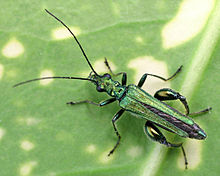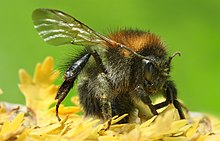1763 taxonomic work by Giovanni Antonio Scopoli
Frontispiece of Entomologia Carniolica Entomologia Carniolica exhibens insecta Carnioliae indigena et distributa in ordines, genera, species, varietates taxonomic work by Giovanni Antonio Scopoli , published in Vienna in 1763. As well as describing hundreds of new species, Entomologia Carniolica queen bees mating outside the hive .[ 1]
Classification
In contrast to his predecessors Carl Linnaeus and Johan Christian Fabricius , who had used the structure of the insect wing and the structure of the insect mouthparts , respectively, as the main means of classifying arthropods, Scopoli favoured a more holistic approach.[ 2]
In Entomologia Carniolica arthropods ), divided into seven orders:[ 3]
Coleoptera (beetles and orthopteroid insects) – species 1–329Proboscidea (= Hemiptera ) – species 330–418Lepidoptera Neuroptera Aculeata (= Hymenoptera ) – species 713–838Halterata (= Diptera ) – species 839–1024Pedestria (various wingless animals, including silverfish , fleas , mites , arachnids , crustaceans and myriapods ) – species 1025–1153
Taxa
The animals described in Entomologia Carniolica Duchy of Carniola (also called the Krain Austro-Hungarian Empire .[ 2] Slovenia .[ 4]
For each species, Scopoli gave references to previously published illustrations and binomial names. Few works using binomial nomenclature had appeared by 1763; those cited by Scopoli include the 10th edition of Systema Naturae Fauna Suecica Carl Linnaeus , and Insecta Musei Graecensis Nikolaus Poda von Neuhaus .[ 3] Entomologia Carniolica described as new . They include:
Oedemera nobilis Cantharis nobilis Emmelia trabealis Phalaena trabealis Camponotus vagus Formica vaga Bombus pascuorum Apis pascuorum Phaonia angelicae Musca angelicae Philoscia muscorum Oniscus muscorum 15. Scarabæus eremita , now Osmoderma eremita
65. Curculio piger , now Cleonus piger
97. Curculio glaucus , now Phyllobius glaucus
112. Attelabus lilii , now Lilioceris lilii
124. Cantharis fulva , now Rhagonycha fulva
146. Cantharis nobilis , now Oedemera nobilis
199. Buprestis salicina , now Smaragdina salicina
264. Carabus catenulatus
408. Aphis fabae
428. Papilio fagi , now Hipparchia fagi
510. Phalaena fulminea , now Catocala fulminea
525. Phalaena rubiginosa , now Conistra rubiginosa
526. Phalaena clavipalpis , now Paradrina clavipalpis
527. Phalaena deceptoria , now Deltote deceptoria
532. Phalaena nebulata , now Euchoeca nebulata
535. Phalaena fimbrialis , now Thalera fimbrialis
537. Phalaena punctinalis , now Hypomecis punctinalis
540. Phalaena lineata , now Siona lineata
542. Phalaena exanthemata , now Cabera exanthemata
545. Phalaena ornata , now Scopula ornata
546. Phalaena sylvata , now Abraxas sylvata
549. Phalaena glaucata , now Cilix glaucata
551. Phalaena chlorosata , now Petrophora chlorosata
561. Phalaena moeniata , now Scotopteryx moeniata
565. Phalaena aurata , now Pyrausta aurata
567. Phalaena ochrata , now Idaea ochrata
571. Phalaena alpinata , now Glacies alpinata
572. Phalaena murinata , now Minoa murinata
575. Phalaena laevigata , now Idaea laevigata
576. Phalaena inquinata , now Idaea inquinata
577. Phalaena tenebrata , now Panemeria tenebrata
579. Phalaena despicata , now Pyrausta despicata
580. Phalaena nigrata , now Pyrausta nigrata
583. Phalaena podana , now Archips podana
591. Phalaena rufana , now Celypha rufana
595. Phalaena montana , now Macrophya montana
599. Phalaena formosana , now Enarmonia formosana
600. Phalaena rivulana , now Celypha rivulana
607. Phalaena anthracinalis , now Euplocamus anthracinalis
609. Phalaena citrinalis , now Hypercallia citrinalis
610. Phalaena trabealis , now Emmelia trabealis
612. Phalaena lunalis , now Zanclognatha lunalis
614. Phalaena extimalis , now Evergestis extimalis
615. Phalaena sericealis , now Rivula sericealis
616. Phalaena ruralis , now Pleuroptya ruralis
618. Phalaena nemoralis , now Agrotera nemoralis
620. Phalaena perlella , now Crambus perlella
627. Phalaena craterella , now Chrysocrambus craterellus
628. Phalaena chrysonuchella , now Thisanotia chrysonuchella
636. Phalaena palliatella , now Eilema palliatella
638. Phalaena forficella , now Harpella forficella
643. Phalaena mucronella , now Ypsolopha mucronella
649. Phalaena rufimitrella , now Cauchas rufimitrella
654. Phalaena scalella , now Pseudotelphusa scalella
660. Phalaena aruncella , now Micropterix aruncella
661. Phalaena alchimiella , now Caloptilia alchimiella
662. Phalaena aureatella , now Micropterix aureatella
673. Phalaena bipunctidactyla , now Stenoptilia bipunctidactyla
734. Tenthredo ribesii , now Nematus ribesii
819. Apis pascuorum , now Bombus pascuorum
833. Formica vaga , now Camponotus vagus
870. Musca maculata , now Graphomya maculata
876. Musca tuguriorum , now Phaonia tuguriorum
880. Musca angelicae , now Phaonia angelicae
954. Conops pertinax , now Eristalis pertinax
962. Conops cuprea , now Ferdinandea cuprea
967. Conops aeneus , now Eristalinus aeneus
1134. Oniscus muscorum , now Philoscia muscorum
Publication
Entomologia Carniolica Johann Thomas von Trattner in Vienna in 1763.[ 5] Entomologia Carniolica [ 2] Aphis [ 5]
Entomologia Carniolica Parisian inches , each divided into twelve lines . His inch was approximately 26.5 millimetres (1.04 in) long, making each line approximately 2.2 mm (0.087 in).[ 2]
References
Further reading
D. B. Baker (1999). "The localities of I. A. Scopoli's Entomologia Carniolica (1763)". Entomologist's Gazette 50 : 188– 189.
External links






